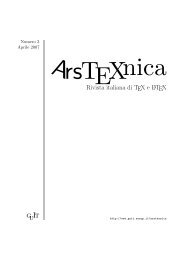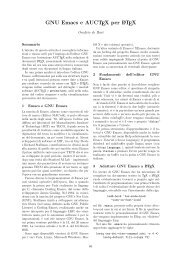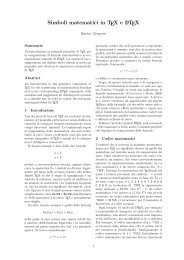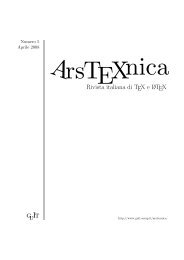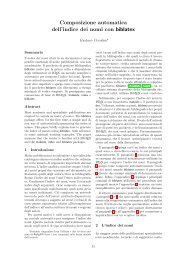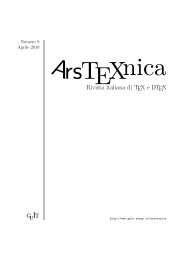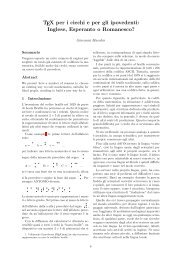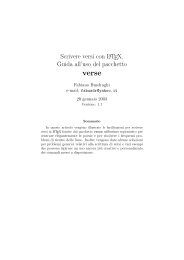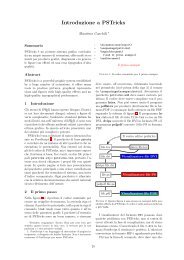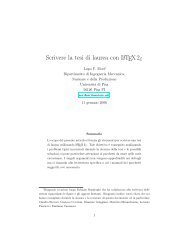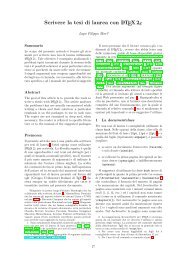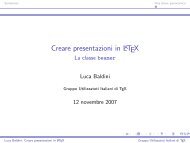Numero 2, 2006 - GuIT - Scuola Superiore Sant'Anna
Numero 2, 2006 - GuIT - Scuola Superiore Sant'Anna
Numero 2, 2006 - GuIT - Scuola Superiore Sant'Anna
Create successful ePaper yourself
Turn your PDF publications into a flip-book with our unique Google optimized e-Paper software.
ArsT E Xnica Nº 2, Ottobre <strong>2006</strong>MlBibT E X’s Architecture<br />
(*top* ...<br />
(book (@ (id "eco1980") (language "italian"))<br />
(author<br />
(name (personname (first "Umberto)<br />
(last "Eco"))))<br />
(title "Il nome della rosa")<br />
(publisher "Bompiani") (year "1980")<br />
(address (symbol (@ (name "roma"))))))<br />
Figure 5: Entry in sxml (Fig. 4 cont’d).<br />
point of view were additional syntactic features.<br />
This approach was not satisfactory enough and we<br />
decided to design a new language for bibliography<br />
styles (Hufflen (2001b)), taking advantage of<br />
xml features as far as possible. This design choice<br />
and the implementation of multilingual features<br />
led to an architecture quite far from BibT E X’s. It<br />
may appear as more complicated, but we think<br />
that the role of each module is precise and can be<br />
understood by end-users, provided that they have<br />
got first experience with the Scheme programming<br />
language. But this architecture seems to us to be<br />
stable and robust. In particular, we succeeded in<br />
using MlBibT E X for deriving ‘References’ sections<br />
for ConTEXt (Hufflen (<strong>2006</strong>b)), another format<br />
built out of TEX 16 and very different from L A TEX.<br />
So, extending MlBibT E X to other output formats<br />
is possible.<br />
A<br />
Abbreviations in MlBibT E X<br />
This appendix aims to make precise how abbreviations—possibly<br />
multilingual—can be specified<br />
in MlBibT E X. As an example, we consider the<br />
roma symbol, that appears in the eco1980 entry<br />
of Figure 3. Another example is given in Hufflen<br />
(2004b).<br />
You can use a @STRING command, like in ‘old’<br />
BibT E X ((Mittelbach et al., 2004, § 13.2.3)):<br />
@STRING{roma = {[Roma] * italian<br />
[Rome] * english<br />
[Rom] * german}}<br />
the sequence of ‘[...] * ...’ notations being a<br />
syntactical extension of MlBibT E X for information<br />
that must be put, possibly in another language<br />
if no translation is available (Hufflen (2003)).<br />
In other words, processing such a sequence never<br />
yields an empty string. But this @STRING command<br />
is expanded verbatim when a .bib file is processed—<br />
as in ‘old’ BibT E X—so it must be put in every .bib<br />
file where this roma symbol is used.<br />
16. TEX provides a powerful framework to format texts<br />
nicely, but to be fit for use, the definitions of this framework<br />
need to be organised in a format. The first formats were<br />
Plain TEX and LATEX, another format, more modern, is<br />
ConTEXt (Hagen (2001)).<br />
A better solution, from our point of view, is to<br />
define this symbol like month names or predefined<br />
names of journals within the standard bst styles<br />
of BibT E X. If the roma symbol is not defined by a<br />
@STRING command, it is processed as we show in<br />
Figure 4 when a .bib file is parsed. It can defined<br />
within a bibliography style—that is, within a .nbst<br />
file—as follows:<br />
<br />
<br />
Roma<br />
Rome<br />
Rom<br />
<br />
<br />
These two ways to define a symbol are close<br />
together, since a sequence of ‘[...] * ...’ yields<br />
a nonemptyinformation element when .bib files<br />
are parsed. However, if an abbreviation has not<br />
been defined in ‘old’ BibT E X, a warning message<br />
is issued and the undefined symbol is just replaced<br />
by an empty string. As mentioned in § 1.2, the<br />
nbst language allows you to check that a symbol<br />
has been defined or not.<br />
Acknowledgements<br />
Many thanks to Maurizio W. Himmelmann for his<br />
patience when he was waiting for the first version<br />
of this article and for its Italian translation of the<br />
abstract. I also thank the referee of this article for<br />
the improvements suggested to me.<br />
References<br />
Hans Hagen: ConTEXt, the Manual. November<br />
2001. http://www.pragma-ade.com/general/<br />
manuals/cont-enp.pdf.<br />
Jean-Michel Hufflen: “MlBibT E X: a New Implementation<br />
of BibT E X”. In: Simon Pepping,<br />
ed., EuroTEX 2001, pp. 74–94. Kerkrade, The<br />
Netherlands. September 2001.<br />
Jean-Michel Hufflen: “European Bibliography<br />
Styles and MlBibT E X”. tugboat, Vol. 24, no. 3,<br />
pp. 489–498. EuroTEX 2003, Brest, France. June<br />
2003.<br />
Jean-Michel Hufflen: “MlBibT E X’s Version 1.3”.<br />
tugboat, Vol. 24, no. 2, pp. 249–262. July 2003.<br />
Jean-Michel Hufflen: “MlBibT E X: beyond<br />
L A TEX”. In: Apostolos Syropoulos, Karl<br />
Berry, Yannis Haralambous, Baden Hugues,<br />
Steven Peter and John Plaice, eds., International<br />
Conference on TEX, xml, and Digital<br />
Typography, Vol. 3130 of lncs, pp. 203–215.<br />
Springer, Xanthi, Greece. August 2004.<br />
58




